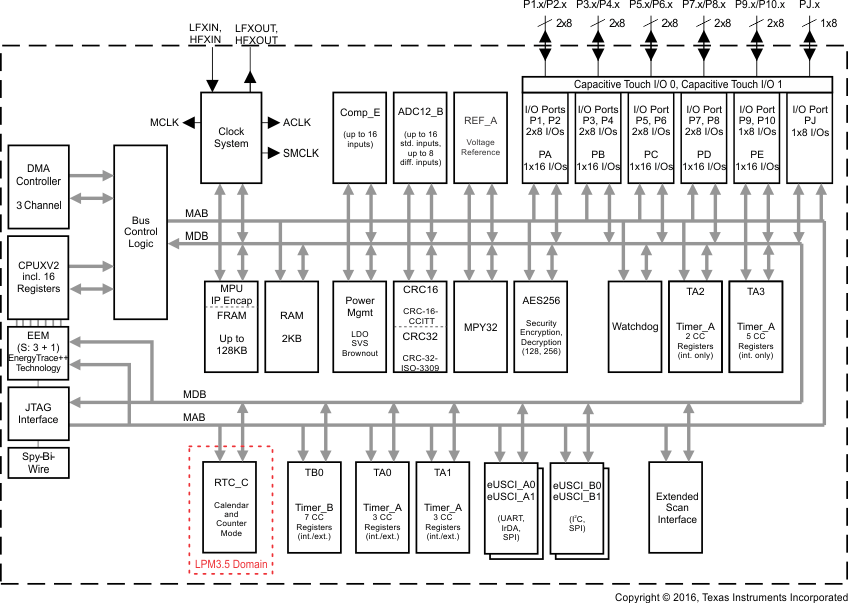ZHCSH48 April 2017 MSP430FR5989-EP
PRODUCTION DATA.
- 1器件概述
- 2修订历史记录
- 3Terminal Configuration and Functions
-
4 Specifications
- 4.1 Absolute Maximum Ratings
- 4.2 ESD Ratings
- 4.3 Recommended Operating Conditions
- 4.4 Active Mode Supply Current Into VCC Excluding External Current
- 4.5 Typical Characteristics, Active Mode Supply Currents
- 4.6 Low-Power Mode (LPM0, LPM1) Supply Currents Into VCC Excluding External Current
- 4.7 Low-Power Mode (LPM2, LPM3, LPM4) Supply Currents (Into VCC) Excluding External Current
- 4.8 Low-Power Mode With LCD Supply Currents (Into VCC) Excluding External Current
- 4.9 Low-Power Mode LPMx.5 Supply Currents (Into VCC) Excluding External Current
- 4.10 Typical Characteristics, Low-Power Mode Supply Currents
- 4.11 Typical Characteristics, Current Consumption per Module
- 4.12 Thermal Resistance Characteristics
- 4.13
Timing and Switching Characteristics
- 4.13.1 Power Supply Sequencing
- 4.13.2 Reset Timing
- 4.13.3 Clock Specifications
- 4.13.4 Wake-up Characteristics
- 4.13.5 Peripherals
- 4.13.6 Emulation and Debug
-
5Detailed Description
- 5.1 Overview
- 5.2 CPU
- 5.3 Operating Modes
- 5.4 Interrupt Vector Table and Signatures
- 5.5 Bootloader (BSL)
- 5.6 JTAG Operation
- 5.7 FRAM
- 5.8 RAM
- 5.9 Tiny RAM
- 5.10 Memory Protection Unit Including IP Encapsulation
- 5.11
Peripherals
- 5.11.1 Digital I/O
- 5.11.2 Oscillator and Clock System (CS)
- 5.11.3 Power-Management Module (PMM)
- 5.11.4 Hardware Multiplier (MPY)
- 5.11.5 Real-Time Clock (RTC_C)
- 5.11.6 Watchdog Timer (WDT_A)
- 5.11.7 System Module (SYS)
- 5.11.8 DMA Controller
- 5.11.9 Enhanced Universal Serial Communication Interface (eUSCI)
- 5.11.10 Extended Scan Interface (ESI)
- 5.11.11 Timer_A TA0, Timer_A TA1
- 5.11.12 Timer_A TA2
- 5.11.13 Timer_A TA3
- 5.11.14 Timer_B TB0
- 5.11.15 ADC12_B
- 5.11.16 Comparator_E
- 5.11.17 CRC16
- 5.11.18 CRC32
- 5.11.19 AES256 Accelerator
- 5.11.20 True Random Seed
- 5.11.21 Shared Reference (REF_A)
- 5.11.22 LCD_C
- 5.11.23 Embedded Emulation
- 5.11.24
Input/Output Diagrams
- 5.11.24.1 Digital I/O Functionality - Ports P1 to P10
- 5.11.24.2 Capacitive Touch Functionality Ports P1 to P10 and PJ
- 5.11.24.3 Port P1 (P1.0 to P1.3) Input/Output With Schmitt Trigger
- 5.11.24.4 Port P1 (P1.4 to P1.7) Input/Output With Schmitt Trigger
- 5.11.24.5 Port P2 (P2.0 to P2.3) Input/Output With Schmitt Trigger
- 5.11.24.6 Port P2 (P2.4 to P2.7) Input/Output With Schmitt Trigger
- 5.11.24.7 Port P3 (P3.0 to P3.7) Input/Output With Schmitt Trigger
- 5.11.24.8 Port P4 (P4.0 to P4.7) Input/Output With Schmitt Trigger
- 5.11.24.9 Port P5 (P5.0 to P5.7) Input/Output With Schmitt Trigger
- 5.11.24.10 Port P6 (P6.0 to P6.6) Input/Output With Schmitt Trigger
- 5.11.24.11 Port P6 (P6.7) Input/Output With Schmitt Trigger
- 5.11.24.12 Port P7 (P7.0 to P7.7) Input/Output With Schmitt Trigger
- 5.11.24.13 Port P8 (P8.0 to P8.3) Input/Output With Schmitt Trigger
- 5.11.24.14 Port P8 (P8.4 to P8.7) Input/Output With Schmitt Trigger
- 5.11.24.15 Port P9 (P9.0 to P9.3) Input/Output With Schmitt Trigger
- 5.11.24.16 Port P9 (P9.4 to P9.7) Input/Output With Schmitt Trigger
- 5.11.24.17 Port P10 (P10.0 to P10.2) Input/Output With Schmitt Trigger
- 5.11.24.18 Port PJ (PJ.4 and PJ.5) Input/Output With Schmitt Trigger
- 5.11.24.19 Port PJ (PJ.6 and PJ.7) Input/Output With Schmitt Trigger
- 5.11.24.20 Port PJ (PJ.0 to PJ.3) JTAG Pins TDO, TMS, TCK, TDI/TCLK, Input/Output With Schmitt Trigger
- 5.12 Device Descriptors (TLV)
- 5.13 Memory
- 5.14 Identification
- 6Applications, Implementation, and Layout
- 7器件和文档支持
- 8机械、封装和可订购信息
1 器件概述
1.1 特性
- 嵌入式微控制器
- 高达 16 MHz 时钟频率的 16 位精简指令集 (RISC) 架构
- 宽电源电压范围(1.8V 至 3.6V)
- 每 SVSH 上电电平所需的最小上电电源电压为 1.99V
- 经优化的超低功率模式
- 工作模式:大约 100µA/MHz
- 待机(具有低功率低频内部时钟源 (VLO) 的 LPM3):0.4µA(典型值)
- 实时时钟 (RTC) (LPM3.5):0.35µA(典型值) (1)
- 关断 (LPM4.5):0.02µA(典型值)
- 超低功耗铁电 RAM (FRAM)
- 高达 128KB 的非易失性存储器
- 超低功耗写入
- 125ns 每个字的快速写入(4ms 内写入 64KB)
- 统一标准存储器 = 单个空间内的程序 + 数据 + 存储
- 1015 写入周期持久性
- 抗辐射和非磁性
- 智能数字外设
- 32 位硬件乘法器 (MPY)
- 三通道内部直接存储器存取 (DMA)
- 带有日历和和报警功能的 RTC
- 5 个 16 位计时器,每个计时器具有多达 7 个捕捉/比较寄存器
- 16 位和 32 位循环冗余校验器(CRC16、CRC32)
- 高性能模拟
- 16 通道模拟比较器
- 12 位模数转换器 (ADC),具有内部基准和采样保持以及多达 16 个外部输入通道
- 具有高达 320 段对比度控制的集成 LCD 驱动器
- 多功能输入/输出端口
- 所有 P1 至 P10 以及 PJ 引脚均支持电容式触控功能,无需外部组件
- 可每位、每字节和每字访问(成对访问)
- 可通过 P1、P2、P3 和 P4 端口从 LPM 唤醒,边沿可选
- 所有端口上可编程上拉和下拉
- 代码安全
- 用于随机数生成算法的真随机数种子
- 增强型串行通信
- eUSCI_A0 和 eUSCI_A1 支持:
- 支持自动波特率侦测的通用异步收发器 (UART)
- IrDA 编码和解码
- SPI
- eUSCI_B0 和 eUSCI_B1 均支持:
- 支持多从设备寻址的 I2C
- SPI
- 硬件 UART 和 I2C 引导加载程序 (BSL)
- eUSCI_A0 和 eUSCI_A1 支持:
- 灵活时钟系统
- 具有 10 个可选厂家调整频率的定频数控振荡器 (DCO)
- 低功率低频内部时钟源 (VLO)
- 32kHz 晶振 (LFXT)
- 高频晶振 (HFXT)
- 开发工具和软件
- 自由的专业开发环境 具有 EnergyTrace++™技术
- 实验和开发套件
- 受控基线
- 一个组装/测试场所,一个制造场所
- 增强型制造源减少 (DMS) 支持
- 增强型产品变更通知
- 资质谱系
1. 实时时钟 (RTC) 由 3.7pF 晶振计时。
1.2 应用
- 水表
- 热量计
- 热量分配表
- 便携式医疗仪表
- 数据日志
1.3 说明
MSP430™超低功耗 (ULP) FRAM 平台将独特的嵌入式 FRAM 和整体超低功耗系统架构组合在一起,从而使得创新人员能够以较少的能源预算增加性能。FRAM 技术以低很多的功耗将 SRAM 的速度、灵活性和耐久性与闪存的稳定性和可靠性组合在一起。
MSP430 ULP FRAM 产品系列由多种采用 FRAM 、ULP 16 位 MSP430 CPU 的器件和智能外设组成,可适用于各种 应用。ULP 架构具有七种低功耗模式,这些模式都经过优化,可在能源受限的应用中实现较长的 电池寿命。
作为一款高可靠性增强型产品,此器件具有受控的基线、扩展的温度范围(–55°C 至 95°C)和金键合线封装,尤其适用于任务关键型 应用。
